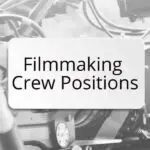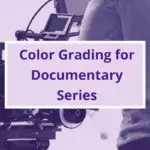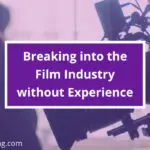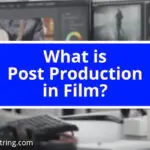Documentary editing is the crucial post-production process which gets your raw footage into a watchable and engaging story arc.
It can often appear overwhelmingly complex to edit a documentary film given the copious amounts of audio files, photos, and unorganized footage.
A strong vision of the final product, coupled with smart techniques and strategies, is essential to prevent this task from becoming paralyzing.
Documentary editing plays a crucial role in molding the final production. It doesn’t matter how well the pieces of the documentary have been shot, if the editing isn’t up to the mark, it can’t make an impact.
- Vital Storytelling Tool: First and foremost, editing is a potent storytelling tool. The right editing can precisely present the key elements of the story and help it flow smoothly, enabling your audience to understand and relate to your film.
- Engaging Narrative: The ultimate aim of every documentarian is to make an engaging narrative. Required pacing, right transitions, and precise cuts, all achieved through solid editing, can weave together all the shots and interviews into a cohesive and engaging story.
- Aesthetic Appeal: Bare facts and interviews seldom attract an audience. They need to be presented in an aesthetically appealing format. Elements such as graphics, effects, and color correction, all fall under the editing spectrum, truly enhancing the visual appeal of your documentary.
- Adding emphasis and emotion: With strategic editing, you can add emphasis to critical parts of the story or evoke particular emotions in your audience. Small tweaks like changing the pace of the story, the style of transitions, the implementation of sound effects have a significant impact on the overall mood of the documentary.
- Saves Resources: Finally, an often overlooked aspect of editing is its ability to salvage mishandled shooting scenarios. Skilled editing can repair minor errors in shooting, often saving significant costs in reshooting.
Pre-Production Planning
One of the main benefits of pre-editing planning is that it helps you to stay focused and avoid going off track during the writing process. By outlining your main points and structuring your ideas beforehand, you will have a clear roadmap to follow. Otherwise, it’s easy to lose your story arc or feel overwhelmed when you get to editing.
Using multiple cameras and B-rolls helps to avoid jump cuts that can look unprofessional and helps add context to the narrative.
Framing shots effectively can lead the viewer’s attention and carry different emotional tones. So different types of shots, including close-ups, wide, and medium shots, should be part of the storyboard process.
Getting this organised in advance means you’ll have the footage you need when you’re in the editing room.
Why is Narrative Planning Important?
The narrative forms the backbone of your documentary project, guiding viewers through the subject matter and creating a compelling story arc from different streams of raw footage and interviews.
Key Elements to Consider in Narrative Planning:
- Setting clear objectives on the message or story you want to convey
- Outlining the key moments or events that drive the story
- Identifying leading characters and their roles in the narrative
- Mapping the documentary’s overall flow including the introduction, climax and resolution
Advice from a documentary Film Editor
Delve into the world of documentary filmmaking and the process of a professional editor, through the discussion of a documentary made abound the experiences of a female Eyptian protester called Sana, and another documentary about a group of Chicgao women who provide early childhood education for young black kids.
Shedding light on their editing process, they reveal that they categorize sound bites into various thematic buckets; prefer using verite scenes and interviews to provide context and guide the narrative; and emphasize the importance of organiation in the editing process.
The video dives into the art of crafting arcs for each character and integrating them into the overall film arc, highlighting the importance of integrating the chronology of events and main ideas in a three-act structure documentary.
YouTube – This Guy Edits: Documentary Filmmaking: Process of a Pro Editor
It also introduces Film Convert, which is an easy-to-use color grading tools for all filmmakers, available for Adobe Premiere Pro, DaVinci Resolve, and Final Cut Pro.
The book “Jacob Brieker’s Documentary Editing Principles and Practice” is recommended for further reading.
Script Supervisor
A script supervisor, or script editor, is a vita role. Even in an observational documentary, which can take twists and turns during filming, script supervision keeps the production organised in a way that prepares the way for editing.
- Ensuring Continuity: One of the main tasks of a script supervisor is to make sure that the film’s content is consistent and coherent. From noting down the details of every shot to maintaining a log of all recorded scenes, the script supervisor ensures there is no confusion or discontinuity in the narrative.
- Liaising with Different Departments: They act as an essential link between many different departments of the film production team. They work in tandem with directors, cinematographers, and editors ensuring seamless communication and coordination.
- Maintaining the Shooting Schedule: A script supervisor is also responsible for keeping a strict check on the shooting schedule. They note the times of each shot and take and directly contribute to keeping the production on track and within budget.
- Script Editing and Notetaking: During the filming process, a script supervisor edits the script if required and takes comprehensive notes about each scene and take.
Techniques used in documentary editing
The entire documentary editing process involves the manipulation and arrangement of footage to create a coherent and compelling narrative.
One technique commonly used in documentary editing is the juxtaposition of shots. This involves placing two shots side by side to create a contrast or highlight a particular theme or idea.
Another technique is the use of montages, which involves the rapid succession of images to convey information or evoke emotion.
Montages can be used to compress time or showcase a series of events.
Another technique is the use of voiceovers or interviews to provide context or insights from experts or individuals involved in the subject matter. This can add credibility and depth to the documentary.
Transitions, such as cuts, dissolves, or fades, are also used to smoothly transition between shots or signify a change in time or location.
The use of sound, including music, ambient noise, or sound effects, is another important technique in the process of editing, as it can set the mood, evoke emotions, or provide information.
Overall, these techniques are essential in creating a visually and narratively engaging documentary.
Linear Editing
You could edit your documentary using the linear editing approach, which involves arranging your shots and sequences in a linear or sequential order.
Pros of Linear Editing:
Simple and Straightforward: Linear editing is a simple and straightforward method. It is easy to comprehend and does not require much technical knowledge as compared to non-linear editing.
• In Timeline Order: In linear editing, scenes are edited in the order that they will appear on the final cut. This makes it easier to keep track of the storyline.
• Consistent and Stable: Linear editing is a consistent and stable form of editing. Changes made are irreversible which eliminates any probable confusion.
• Economical: Linear editing is relatively cheaper as it doesn’t require expensive editing software or high-end hardware.
• Feasible for Short Films: It is a suitable option for short films or videos where vast editing is not required.
Cons of Linear Editing:
• Time Consuming: Linear editing is a time-consuming process, as any changes require the editor to start from scratch.
• Lack of Flexibility: It is less flexible as compared to non-linear editing because once a change is made it is permanent.
• Can’t preview Changes: Unlike non-linear editing, changes cannot be previewed before finalizing which may lead to a few errors.
• Limited Special Effects: Linear editing lacks the ability to include and work with high-quality special effects and graphics.
• Hardware Dependent: This type of editing is mostly dependent on video tape machines, thus limiting the possibilities.
• Complex Multilayering: Creating complex multilayering and compositing of videos is quite difficult and limited in linear editing.
• Lower Quality Output: Comparatively, linear editing struggles to maintain high quality output especially when multiple edits are involved.
Non-Linear Editing
With non-linear editing, you aren’t required to follow a particular sequence when editing your film. Unlike its linear counterpart, you can access any frame of the filming sequence regardless of its position in time.
Freedom to Experiment: This flexible technique ushers in endless possibilities, offering you the freedom to experiment until your movie or video is an exact representation of your vision.
Convenience: In addition, the convenience of non-linear editing can’t be overemphasized. You can jump to any part of the video or film without disrupting the original version.
Creative Control: This method of editing also grants you greater creative control, enabling you to try different edits or versions of a scene and then choose the best one.
Cost-Effective: Besides, extensive re-editing on a traditional linear editing system could be cost-prohibitive as it was a labor-intensive process. Non-linear editing, on the other hand, isn’t as laborious and thus could help you keep your budget in check.
Montage Editing
Montage editing uses a series of short shots to express an idea or tell a story in a condensed form.
It allows complex stories to be told swiftly and effectively, and encourages active participation from viewers as they interpret the sequences. Whether you’re aiming to elicit laughter, tears or gasps, mastering this technique can greatly enhance your unique storytelling style.
- The Idea: Montage editing revolves around assembling disparate images to create new meanings. It’s a throwback to the Kuleshov experiment from the early days of cinema. As opposed to linear storytelling, a montage can convey a large amount of information in a short time.
- Types of Montage: There are different forms of montages, including metric, rhythmic, tonal, thematic, and intellectual. Each has its own unique, underlying principle, and when used effectively, they can provoke diverse emotional responses from your audience.
- Role in Filmmaking: Montage editing plays a pivotal role in filmmaking as it can escalate the pace of the narration, bridge time and space gaps, or serve to compare and contrast divergent ideas. This method is often used in films to show passage of time, character development, or a series of events.
| Montage Type | Application | Effect |
|---|---|---|
| Metric | Editing dictated by a specific number of frames | Creates tension or excitement |
| Rhythm | Editing follows rhythmic flow from scene to scene | Can create smooth, cohesive transition |
| Tonal | Controlled by the emotional tone of the scenes | Can evoke specific emotional reactions |
| Thematic | Tied together by a thematic idea | Clarifies or underscores a theme |
| Intellectual | Derived from the mental connections among shots | Can stimulate intellectual responses |
Documentary Filmmakers: Editing Tasks and Function
| Tasks | Function |
|---|---|
| Assembly of Footage | Organizing the scenes and interviews |
| Rough Cut and Fine Cut | Structuring the storyline |
| Sound Editing | Adjusting audio for clarity and impact |
| Colour Correction and Grading | Ensuring a consistent visual tone |
| Titles, Graphics, Transitions | Creating engaging and informative visual elements |
Logging and organizing footage
Logging and organizing footage is a crucial step in the post-production process of video editing.
First, the raw footage is ingested into a video editing software, such as Adobe Premiere Pro.
Each clip is then meticulously watched and annotated to identify its content. This annotation can include details like the name of the scene, timecode, shot type, and any relevant dialogue or action. These annotations are referred to as metadata and play a significant role in categorizing and searching for specific footage during the editing process.
Once all the footage is logged, it is organized into folders or bins based on different categories like location, characters, or events.
This organization ensures that the footage is easily accessible and helps prevent any confusion or time wastage during the process of editing. Proper logging and organizing of footage is essential for a smooth and efficient video editing workflow, ultimately resulting in a high-quality finished product.
Films on a Shoestring is reader supported. As an Amazon Associate I earn from qualifying purchases. When you buy through links on this site, we may earn an affiliate commission, at no extra cost to our readers.
The Rough Cut
The editor starts by reviewing all the footage captured during the filming process. They then select the best takes and organize them into a rough cut, which serves as the initial structure of the documentary.
Next, the editor refines the sequence of shots, paying attention to the flow and pacing of the visuals.
The editor might also include graphics, animations, archival footage, or panning slowly across old photos using the Ken Burns effect. All these help retain the audience focus and enhance the storytelling.
Structure
Structure in documentary editing is an essential element that helps to shape the overall narrative and communicate the intended message to the audience effectively.
In order to create a well-structured documentary, editors utilize various techniques and strategies.
First and foremost, they carefully select the footage that best supports the story and discards any irrelevant or unnecessary shots.
Additionally, editors arrange the selected clips in a logical and coherent manner, ensuring a smooth flow of information and events. They also incorporate transitions, such as fades or cuts, to help seamlessly connect different scenes or topics.
Furthermore, editors may use additional visual elements, such as text overlays or graphics, to provide context or emphasize key points.
The overall aim of structuring a documentary is to engage the audience and guide them through the narrative in a way that effectively conveys the intended message while maintaining their interest and attention.
By carefully crafting the structure, documentary editors can create a captivating and impactful viewing experience for the audience.
Selecting the Most Compelling Footage
The next important step in documentary editing is to select the most compelling footage.
Accuracy and authenticity are key in this step.
Authentic footage that highlights key moments and propels your narrative forward is a must-have in every documentary.
Cutting unnecessary footage
Make your documentary stay focused on your central theme. Sometimes that means parting ways with unnecessary footage.
While every shot may hold a level of sentimental value to the filmmakers, it’s essential to prioritize the clarity and coherence of the narrative over personal attachments to specific scenes.
An efficient documentary editor scrupulously trims down excessive footage, ensuring that every scene contributes significantly to the story.
Crafting a Cohesive Structure
Once you have your footage and narrative in place, it’s time to shape it into a cohesive structure. Intertwining different elements such as interviews, footages, and voice-overs together to create a smooth, engaging flow needs special attention.
Incorporating Interviews and Voiceovers
Incisive interviews, gripping voice-overs add depth to your documentary. Skilful blending of these components brings out the emotional elements of the story, building an intimate connection with the audience.
Editing footage gathered from real-life events or interviews poses several challenges.
- Firstly, the sheer amount of raw footage can be overwhelming. Depending on the event or interview, there could be hours and hours of footage to go through, which requires careful organization and thorough review to identify the most relevant and coherent segments.
- Secondly, maintaining objectivity during the edit can be difficult. Documentary filmmakers, for example, may have a particular agenda or story they want to tell, and this can influence the way they select and edit footage, potentially distorting the truth.
- Thirdly, editing real-life footage often involves dealing with sensitive or controversial subjects. Balancing the need for an accurate representation of events with ethical considerations can be a delicate task.
Editing interviews, on the other hand, poses additional challenges such as preserving the interviewee’s intended message while ensuring clarity and coherence.
Overall, editing footage gathered from real-life events or interviews requires a meticulous and ethical approach to present a fair representation of the subject matter.
Pacing
Pacing is another critical aspect to consider while editing a documentary. Balancing the speed at which the story unfolds can greatly affect the audience engagement and understanding. A well-edited documentary should smartly intersperse fast-paced, intense sequences with slower, calming ones to allow the audience some breathing room, keeping them invested without feeling overwhelmed.
Rhythm
Rhythm in filmmaking plays a fundamental role in connecting the audience to the story. It’s the heartbeat of a film and greatly influences how viewers perceive the emotional depth, pace, and tone.
Consider these elements to understand rhythm in filmmaking:
- Pacing and timing: The pace at which scenes unfold, the length of shots used, and pauses can all create rhythm in a visual story. A quick pace brings in action and excitement, whereas slow pacing can create suspense or emotional depth.
- Editing: Film editing significantly contributes to the rhythm. By positioning different shots and sequences, the editor weaves a rhythmic pattern that either agitates or soothes viewer emotions.
- Sound and Music: Soundtracks, ambient noise, dialogue, and silence- all contribute to film rhythm. The right pairing of visuals and sound can create a certain rhythm that excites, frightens, or moves the audience.
Remember, rhythm isn’t simply about fast or slow; it’s about how effectively you combine elements to evoke the desired emotional response.
Some films may have a constant rhythm throughout, while others may shift the rhythm, mirroring the various moods within the story. Recognizing and leveraging rhythm can help make your filmmaking more dynamic, engaging, and effective. Considering rhythm as an additional character in your story can truly elevate your craft.
Sound Design
A truly captivating film doesn’t just rely on sound visuals; it needs an equally compelling auditory experience.
Working on the audio, the foley mixer and sound designer get busy on dialogue and sound effects, adjusting levels and adding background music or narration. Sound effects, such as footsteps, background noise, or ambient sounds, bring the viewer into the scene and provide a sense of place.
Additionally, carefully selected music can evoke emotions, set the tone, and enhance the narrative. Sound also contributes to the pacing and rhythm of the documentary.
Sound enhances the storytelling and overall impact of the film. It helps to create an immersive experience for the audience by adding depth and realism to the visuals.
By manipulating the timing and intensity of sounds, editors can create tension, build suspense, or evoke a sense of calmness. Moreover, sound can be used to emphasize certain elements or ideas in the documentary, by drawing attention to specific sounds or creating contrasts between different sounds.
Fine Cut
Once the visuals and audio are synchronized, the editor fine-tunes the pacing, trimming unnecessary shots and adjusting transitions.
Each scene is a piece of a beautiful puzzle; a component of a riveting story you’re trying to narrate through moving pictures and sounds.
This process is iterative, with frequent feedback from the director or producer to ensure the desired outcome.
Finally, after multiple rounds of revisions, the documentary is ready for a final polish, including color grading and sound mixing, before it is ready for distribution.
Collaboration between the editor and director
Collaboration between the editor and director is crucial in the post-production phase of filmmaking.
The editor works closely with the director to bring the vision to life and create a seamless narrative.
They work together to select the best takes, arrange the shots in a logical order, and make sure the pacing and rhythm of the film are effective. The editor analyzes the footage and makes creative decisions while keeping in mind the director’s intentions.
Communication is key during this collaboration, as the editor needs to understand the director’s vision and convey it through the editing process.
The director provides guidance and feedback to the editor, giving them a clear understanding of the desired outcome. This collaboration ensures that the film reflects the director’s vision and achieves the desired impact on the audience.
The editor enhances the director’s storytelling by bringing their expertise and technical skills to the process. Together, the editor and director create a cohesive and visually engaging final product.
Notable examples of exceptional documentary editing
Exceptional documentary editing creates immersive storytelling experiences that engage, inform, and even alter perspectives. Some landmark examples of outstanding documentary editing include:
- “The Civil War” (1990): Edited by Paul Barnes, this Emmy-winning documentary by Ken Burns effectively uses still photos, narration, and interviews. The magic lies in how the images, combined with the rhythm and pacing, manage to tell a gripping story of a historical event.
- “Man on Wire” (2008): This thrilling documentary traces the story of Philippe Petit’s high-wire walk between the Twin Towers in New York. The editors, Jinx Godfrey and James Marsh, adroitly intersperse interviews, archival footage, and dramatized sequences to heighten the suspense.
- “An Inconvenient Truth” (2006): Edited by Jay Cassidy and Dan Swietlik, this enlightening documentary on global warming ingeniously blends conversations, slideshows, and archival footage. This technique helps to present complex climate change data comprehensibly.
- “Citizenfour” (2014): Mathilde Bonnefoy, using a method of observational editing, presents the real-time unfolding of Edward Snowden’s revelations about the NSA’s surveillance program. The slow, deliberate pacing ratchets up the tension and paranoia, mirroring the film’s themes.
- “Grizzly Man” (2005): directed by Werner Herzog and edited by Joe Bini. The film chronicles the life and tragic death of Timothy Treadwell, a bear enthusiast who lived among grizzly bears in Alaska. The editing in this documentary is particularly notable for its ability to create tension and build suspense, weaving together Treadwell’s own footage with interviews and narration.
A powerful documentary needs great editing
Whether you’re a student making your first documentary, making an observational documentary of a complicated subject, or telling a factual tale from recent history, chances are you’ll end up with hundreds of hours of footage.
The process of editing gets random scenes from your hard drive into a coherent story of less than two hours.
It doesn’t matter if you’re trying to pass on a social and political message or just tell a story of people doing something quietly important to their everyday lives, your story arc must be coherent and engaging. The audience must be rooting for someone or something.
Achieving that engagement is what the best documentary film does.
More for Filmmakers
- Low Budget Filmmaking: More for Less
- Lighting Department Film Roles
- Shooting An Interview
- Documentary Editing
- What is Sound Design in Film?
- Color Grading for Documentary Series or Film
- Film Set Etiquette: Professional Behaviour on Set
- Observational Documentaries And Their Impact
- Essential Skills for Film Industry Professionals
- How to Create a Storyboard in 6 Simple Steps
- What Makes a Film Successful
- Breaking into the Film Industry without Experience
- Sports Documentary Filmmaking
- How to Create a Storyboard Using Sticky Notes
- Remove Background Noise From Video
- Why Do Filmmakers Use Clapper Boards?
- Indie Films
- Indie Filmmaking
- What is Post Production in Film
- Ken Burns Effect: Creating Eye-Catching Sequences
























